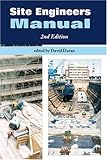| Title: | Site Engineers Manual |
| Categories: | Construction |
| Authors: | David K. Doran |
| ISBN-10(13): | 1904445705 |
| Publisher: | Whittles Publishing |
| Publication date: | 2009-07-31 |
| Edition: | 2nd Revised edition |
| Number of pages: | 520 |
| Language: | English |
| Picture: |

|
| Review: |
The summers of 62, 63 and 64 were my first exposure to being a 'site engineer' experienced as a student during University summer vacations. The middle summer vacation being extended to 6 months to allow time for our experience of engineering being applied, this was the effort of integrating the engineering science of my University course with the practice of engineering. After graduation there were two years of 'design office experience' and then I was back on site at Hinkley Point B Nuclear Power Station followed by the Invergordon Aluminium Smelter. Out on site was where engineering became reality. It was where I wanted to be. It was where I felt we were making it happen. Everything upstream from the site engineer was paperwork, theory, design, discussion, meetings, planning but downstream from the site engineer real construction took place excavation, concreting, brickwork, steelwork and the buildings and infrastructure were actually built. The design engineer produced designs but the site engineer produced the physical construction. From where I was looking at the world no one could help but be inspired by construction that was actually constructing. However in those days Engineering Degrees concentrated on Engineering Science and the practice of Engineering Application was demoted as something that could be learned later and reference to it in taught material was superficial. Yet without construction all the planning, calculation and design that preceded construction was only a heap of paper, or these days a set of computer files, Later in my experience, now an academic, we noted that some 40% of graduates were joining contractors and the Institution of Civil Engineers' guidelines for undergraduate degrees, after 'persuasion', in the mid-eighties finally included reference to construction. This has improved undergraduate degrees but not a lot and pressures from activities such as research assessment etc have led Universities to seek staff who can publish well and usually in theoretical journals. Thus the presence of engineering practice still does not reflect its importance or the needs of industry. So reading this 'Site Engineers' Manual' was , for me, a delight and a regret that I didn't have such a manual when I was a young site engineer. It was the site foremen, the workmen and the older engineers that taught me the knowledge needed to be a site engineer. This manual catalogues that knowledge and provides a great service to all aspiring and practicing site engineers. The editor has assembled 15 authors each specialized in an aspect of construction to present this fairly comprehensive manual of site engineering The authors, some who I know personally, write with great authority based on experience, this is no theoretical work this is how you do it. The topics dealt with in individual chapters are: Quality Management; Working with the Weather; Construction Plant; Setting Out; Flexible Roads and Other Paved Areas; Drains, Sewers and Services; Earthworks and Excavations; Foundations; Mastic Asphalt; Masonry; Formwork, Scaffolding, Falsework and Facade Retention; Reinforcement; Concrete; Structural Steelwork; Timber; Exterior Cladding and Interior Finishes; Glass; Building Engineering Services; Health, Safety and Law; and Occupational Health in Construction. To quote the editor from his introduction: 'Site Engineers operate in an increasingly technological and legalistic environment. It is hoped that this book will provide the road map to guide them.' I believe it certainly does. The purists would argue that this book covers too many topics in insufficient detail and that most chapters could be expanded into a book on its own. However such a criticism would lack an understanding of reality. Site Engineers would not buy too many books and as the editor says this book is the road map. If Site Engineers need more detail they can find it but they do need a starting point and this manual serves as that. The editor also catalogues the origins of the text starting as a Company Manual from within Wimpeys to a bound text to be carried by the Site Engineers in their donkey jackets to, eventually, a published book. Although labelled a 2nd Edition the editor says if all the company editions are counted this would be the 5th Edition. So it is a text that has stood the test of time and has evolved and its DNA is deeply rooted in engineering as practiced on site. The new chapters in this edition cover the topics of: Glass; and Occupational Health. For me this book is nostalgia. For the young Site Engineer it is an essential reference work. Ronald McCaffer |



